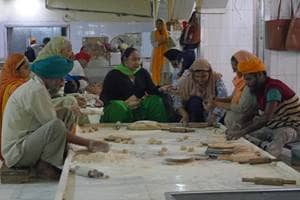
Religion Behind the Scenes spotlights the less discussed, but no less crucial, tasks that keep religious communities running, and the people who make it all happen.
Other than their uncut hair, beards, and turbans (commonly seen on members of the Sikh Khalsa), one of the most recognizable aspects of Sikhism is the Langar—or communal kitchen. At the Golden Temple’s langar, approximately 50,000 people eat for free each day; and, on holidays and religious occasions, approximately 100,000 are fed.
For nearly two decades, Sara Kaur has been part of serving others through her gurdwara’s langar. Indeed, she and her family have been an integral part of the Sikh community in the state of Utah, serving in many capacities in their local gurdwara and community. In this interview, she shares some “behind the scenes” details about the langar, how it is made, and what it means for practitioners of Sikhism.
How would you explain (to someone who is not a practitioner of Sikhism) what the langar is?
So, it’s a meal that we do as a symbol of our rejection of any form of the caste system—sexism, racism, religious discrimination or denominationalism—and to say that all are one, all are equal, and God loves all of us. Sikhs believe that these various religions which exist are different paths to the same God. So, when you go to the langar, the people don’t ask you “What caste are you?” They don’t ask, “Are you Hindu?” “Are you Mormon?” “Are you Muslim?” They serve everyone equally. And then the people feel like a family.
The meal is always vegetarian, because a chicken you might kill, for example, is a living thing. So, the Teachers—the Gurūs—said these are living things and they have a right to live. We cannot kill. And that’s why langar is always vegetarian.
To be sure that we see each other as family, we all come together, we think of each other as brothers and sisters, and we eat together like a family having dinner together. There is no difference in caste, race, gender, or religion. You cannot say “I cannot serve this person because he is from the lower caste.” If you say that, then you realize that you are not a Sikh, and you need to be out from the gurdwara. A Sikh should never say that.
And another thing; whoever comes to a Sikh’s house cannot go hungry. You must always have something to feed them.
So how did the langar first get started?
As you know, the word “gurū” means “teacher”—and we have had 11 teachers or Gurūs in Sikhism. The first ten are no longer alive, but the 11th Gurū is the Gurū Granth Sahib—our holy book, our spiritual book, our scriptures.
So, when our first teacher, Gurū Nānak, was young, his dad gave him some money to do some business. But, when he was taking the money to do the business, he saw ten Hindu people, and they were hungry. And so, he spent all of his money to buy food to feed those people. When he came back with empty hands, his dad was really mad. But Nānak said that feeding those hungry people was more important than doing business. So, that was the beginning of the langar, or the foundation for the practice of the langar that we do today.
Gurū Amar Das was our third Gurū. India is famous for the caste system—upper caste, lower caste. The various castes don’t eat with each other. The upper caste always sits above, and the lower caste always sits on the floor, below those of a higher caste. And this system of castes was behind why they started the langar at the Golden Temple. Gurū Amar Das wanted to end this caste system. He said “Whoever comes in among the Sikhs, they are welcome. Nobody can leave empty. Nobody can go hungry.” He said that there is not upper class and there is not lower class. When people come to the Gurdwara, they are all equal. They all sit on the floor together. It doesn’t matter if you are the prime minister, or if you are a cleaner at the store. It doesn’t matter. All sit in the same line. They all sit together. We are all human beings; we all are equal. And we are all brothers and sisters. So, the langar reminds us that we need to be sharing everything and treating everyone as our equal. Not just treating them that way, but really believing that about them.
It is said that between 50 and 100 thousand people are fed every day at the Golden Temple. Since everyone is always feed for free, where does the money and food come from to support the langar?
We donate a 10th of our earnings. You know, not everybody does that, but that is what we are encouraged to do. The langar is run entirely on the donations of the Sikh people. If somebody, like a farmer, grows rice, then they bring a full truck of rice to the langar. If somebody grows a lot of potatoes, they bring a truck of potatoes. Everything functions through donations. It doesn’t matter if you donate $1 or $100,000.
Is it harder for a small gurdwara outside of India to have sufficient money and food to run the langar when you have a much smaller Sikh community than, say, in the Punjab?
Nope! With God’s blessing, we always have enough.
You know, you never see a Sikh on the side of the road begging for help. You never see it. It’s probably God’s blessing. Sikhs are very hard workers. Many came from India, arriving with zero dollars. God blesses them and, today, they have everything they need. They work so hard. Sikhs help a lot, and they help everyone who has needs. Not just their own. If you give freely, God blesses you in return. So, everything is achieved through a donation. Somebody donates $1, $10, or $200. It doesn’t matter how much you give. We always have enough.
I have seen both men and women serve the langar. How do you decide who cooks, who serves, and who cleans up?
There is no specific assignment for men or women. As a female, I can do anything that a man can do as part of the langar. Anybody can do anything. There are not specific duties for men and women. 500 years ago, there was the differentiation between men and women because of the caste system. So, in Hinduism, for example, women have certain jobs—and men don’t do those things. And men have specific jobs they do, which women are not allowed to do. But the Sikh Gurūs said “No! Whatever God has made is equal with whatever else He has made.” We are all equal in God’s eyes. So, it doesn’t matter which job you do. We just share the responsivities. Wherever you find a job, wherever you find a place, you just start doing what needs to be done.
What do you think motivates members of the Gurdwara to help out with this work?
For me, when I’m doing the langar, I feel like my God is somewhere here in these people that I’m serving. I feel in my heart that, when I’m feeding these people, He is here somewhere. You can’t see God. You just can feel God. Right?
When I participate in making or serving the langar, I prepare with happiness and joy. Even my kids, who were born here in the United States, get very excited. When they serve, they feel such happiness, so much joy. We call it “sewa,” which means “selfless service.” For me, it gives me satisfaction when I am feeding people. The food goes into their bodies but, in return, this brings me and my kids some blessings. While the people are enjoying the food, I am getting God’s blessings because I have served others.
When you’re sharing, you feel happiness; but we do the langar either way—in our happiness, but also in our sadness. So, if someone dies, we do the langar. If there is a wedding, then we do the langar. On either occasion, we do the langar. So, suppose my mom passed away. When I do the langar, I’m thinking to myself, “My mom’s somewhere here, and she is seeing these people.” That brings me satisfaction. My mom is watching me. She’s happy that I’m doing this. And, maybe in one of these people being fed, God is also present. That all gives us inspiration to do the langar.
It seems like there would need to be a lot of coordination to pull something like this off—particularly at larger gurdwaras, like the Golden Temple, in India. How do you organize something like this to make sure that it happens?
There is a langar committee that makes sure it comes together, but there are also a lot of volunteers who help. But it is still the responsibility of the langar committee. I’ll give you a simple example. At my Gurdwara, they put together a calendar which includes every Sunday of the year. (In our gurdwara, we only do the langar on Sundays.) Once the calendar is organized, it is posted on the notice board and whoever would like to sign up can. So, for example, I have three kids. When their birthday comes, I will write down my name on the calendar so that Sunday will be our turn for langar. Okay, suppose that no one signed up for next Sunday. Who is going to be responsible for the langar? The managing committee. It is their responsibility to take charge if no one signs up. They may do it themselves or they may contact someone from the gurdwara and ask them to do the langar that Sunday.
And, in a place like Amritsar, or in a larger Gurdwara, it is done the same way. They too have committees, big committees. Amritsar is the main langar, and they give us all the guidance on how things should be done.
Are their aspects of making or serving the langar that might surprise people, or misconceptions people have about the langar—particularly non-Sikhs?
Well, this is not a misunderstanding, but might surprise some. We have Hindus locally who will go every Sunday morning to their temple to do their prayers, but then—when they want to eat afterwards—they come to the Sikh gurdwara for the langar. Every Sunday! I have gotten so many emails (during the pandemic) from Hindus, asking, “When are you going to open the Gurdwara?” They miss the langar.
Sometimes we will have Christians who will come to the gurdwara on a Sunday. I will go and say hello. When we have our break, I will tell them, “If you want, you can go downstairs and eat some breakfast. There’s a buffet. It’s totally free.” They are often surprised, and say, “Oh, really? We did not know that. We just came to see the congregation and how you worship.” I’ve had that experience a number of times. People learn about Sikhism from their books, but sometimes they don’t know about the free langar.
What’s the most sacred or holy part of the langar?
I think the most holy thing about the langar is the sharing, sitting and sharing with your brothers and sisters. Eating together, sitting together, sharing your food, your love, your feelings with each other. There is perfect equality between you and those you eat with. That’s the most important and sacred thing about langar.
When anybody comes hungry to the gurdwara, it doesn’t matter whether they are Hindu, Muslim, or whatever, they are fed and they are equal with you.
When people are hungry or need help, they will often look for a gurdwara. You know why they look for a gurdwara? Because they know that there they will find help. You will find food, you will find a place to stay (if you need one), they will help you a lot. Sikhs will always help you beyond what you think. Again, it is about how the langar teaches us to share and to give freely. So, that’s the idea.
How has participating in the langar helped you personally or influenced you spiritually? How has it made you a better person, or changed you as a human being?
It really has changed me. You know, in the beginning, when I was a teenager, I was very different in my thinking. So, for example, I would see a Hindu come to the gurdwara to eat, and I would think to myself, “Why don’t they go somewhere else to eat? Why do they come to my gurdwara, instead of going to their own temple?” That was the way I thought when I was younger. My husband would say, “If you think like that, you’re not a true Sikh. You’re not serving the langar from your heart. When they come, it doesn’t matter where they’re coming from. It’s none of your business. When they come to the gurdwara, they’re your guest. You need to just serve them without asking why they come here.” I really feel that’s true. This has changed me. Like, when I’m serving someone who has come, I feel like I’m doing a good thing—without any partiality, without any racism, without any discrimination. I feel a satisfaction in that. I feel like it brings my temper down, and my anxiety down, and it gives me satisfaction and a peace of mind. It cleanses my brain of racism and classism. This is how it has changed my thinking when compared to how I thought as a younger woman.
Have you ever had an experience with a langar where something unique happened? Either in preparing or serving it?
Yes. When the Parliament of World Religions was held in Utah, in 2015, every day we made and served langar to 10,000 people at the Convention Center downtown. That was a great experience. We had Sikhs who came from London to help make and serve the langar. And people from Los Angeles, and from lots of different places. We all worked together, and we all served together. That was a great once-in-a-lifetime experience.
One funny thing about that experience. Because my husband and I were so involved in langar at the Parliament, people assumed we were baptized Sikhs who don’t cut their hair and don’t wear makeup. They expected my husband would have a beard and a turban. (They didn’t see him because he was working behind the scenes, cooking and preparing.) And the last day, when they saw my husband, everybody was shocked because he has short hair and no beard. They didn’t say anything, but you could see from their body language that they were surprised. I explained to them that it is hard for him to work in the heat, making the langar or working at our restaurant, with a long beard and long hair. He has tried so many times to grow his hair out, but he’s said that it is really hard to work in the kitchen like that. In his heart, he is a pure Sikh, but he doesn’t show that through some outward appearance that you can see on his body. So, everyone was surprised because they had a mental picture of what he would look like, since he was helping to serve 10,000 people langar.
Is there any difference in how a local gurdwara does the langar, as opposed to how it is done at the Golden Temple in Amritsar?
Well, in Amritsar, it never stops. It’s made and served 24 hours a day. It just is constantly going. It’s not that way at our small gurdwara. People in India can go partake of langar every day. Here, at our local gurdwara, we only prepare and serve it at the gurdwara on Sundays. And here, we first make and serve breakfast. We do a lot of sweets and breakfast items. And after that, after our congregation is done, we do a lunch. But in India, when you go to the Golden Temple, they just have roti and sabzi. All of the time, just roti and sabzi. But here, in the morning, we do breakfast—like we do fried foods, some snacks, and then fruits and lots of sweets. In India they don’t do that. It’s just dinner all of the time: roti, sabzi, dal. Here we serve those things for lunch. Because we are small scale, we still do the tradition, but in a limited way.
There’s another difference here, in comparison to the langar in India. Here if, for example, it is my daughter’s birthday, I would do the langar at the gurdwara, and I would make so many items, special dishes and snacks. I can do that, to celebrate her birthday, because there will be limited people attending at our small gurdwara. Over there, there are countless people who come to the gurdwara every day. So, they could never do a special langar for a 16-year-old’s birthday, like we do here. Here, we do like a party. Over there, they don’t do that.
Are there any other things that a person, who is not a Sikh, should know about the langar?
Well, perhaps this. Thiry years ago, in America, most people would not have known what the langar is, or even know much about Sikhism. And it was harder to be a Sikh in the United States or Canada back then. But Sikhs back then did their work. They did their jobs. They laid a foundation for the next generation. So, because of those who came before us, those of us today don’t have to explain to everybody what the langar is. Those who came before us have done a lot for us. On top of that, media has changed. So, today, if people wonder what the langar is or what Sikhism is, they just pick up their phone and do a quick Google search to find out. So, people understand these things better than they ever did before. The internet has left very little that you have to guess about.
Interview conducted, transcribed, edited, and condensed by Alonzo L. Gaskill.
ABOUT ALONZO L. GASKILL, PH.D.
Alonzo L. Gaskill is an author, editor, theologian, lecturer, and professor of World Religions. He holds degrees in philosophy, theology/comparative religion, and biblical studies. He has authored more than two-dozen books and numerous articles on various aspects of religion; with topics ranging from world religions and interfaith dialogue, to scriptural commentaries, texts on symbolism, sacred space, and ritual, and even devotional literature.
11/7/2022 8:18:48 PM








